Say the name Fabergé and most people will immediately think of the Imperial Easter eggs – and for good reason, because even today the craftsmanship and detailed execution of those eggs are still breathtaking.
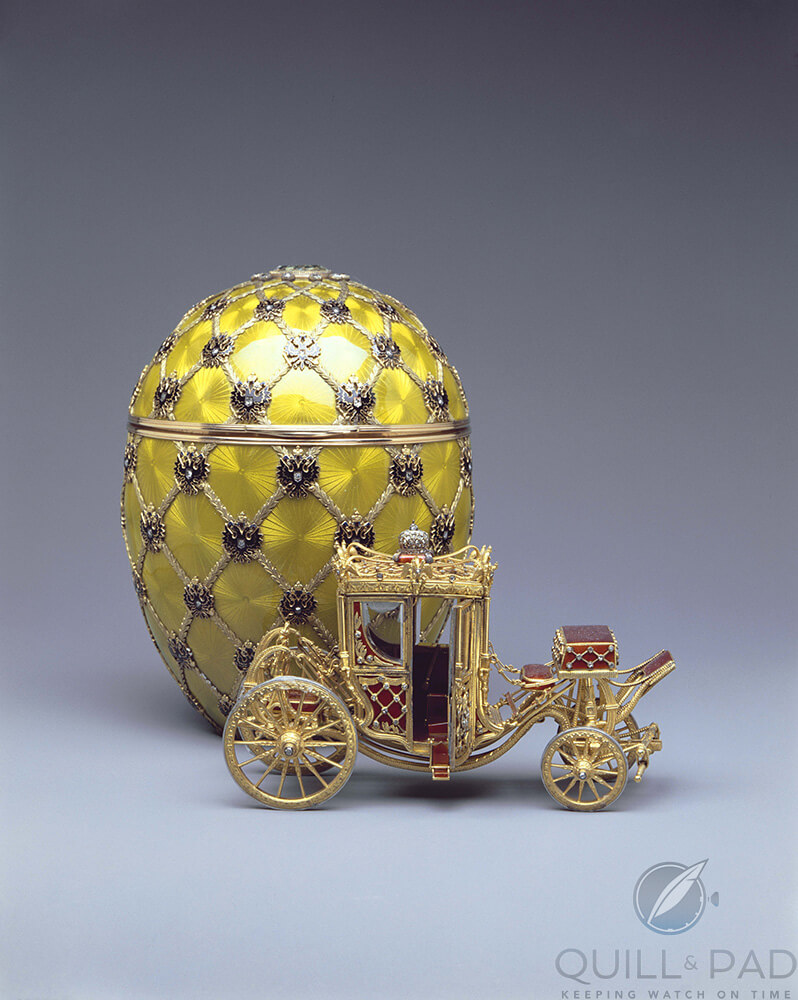
Pre-1917 Fabergé Coronation Egg (photo courtesy The Forbes Collection)
Fabergé was founded in 1842 by Gustav Fabergé, but it was his son Carl, that truly drove the family business to new heights. His restoration work on objects in the collection of the Hermitage Museum caught the attention of Tsar Alexander III. Taken with Fabergé’s work he bestowed upon him the title of “goldsmith by special appointment to the imperial crown” in 1885.
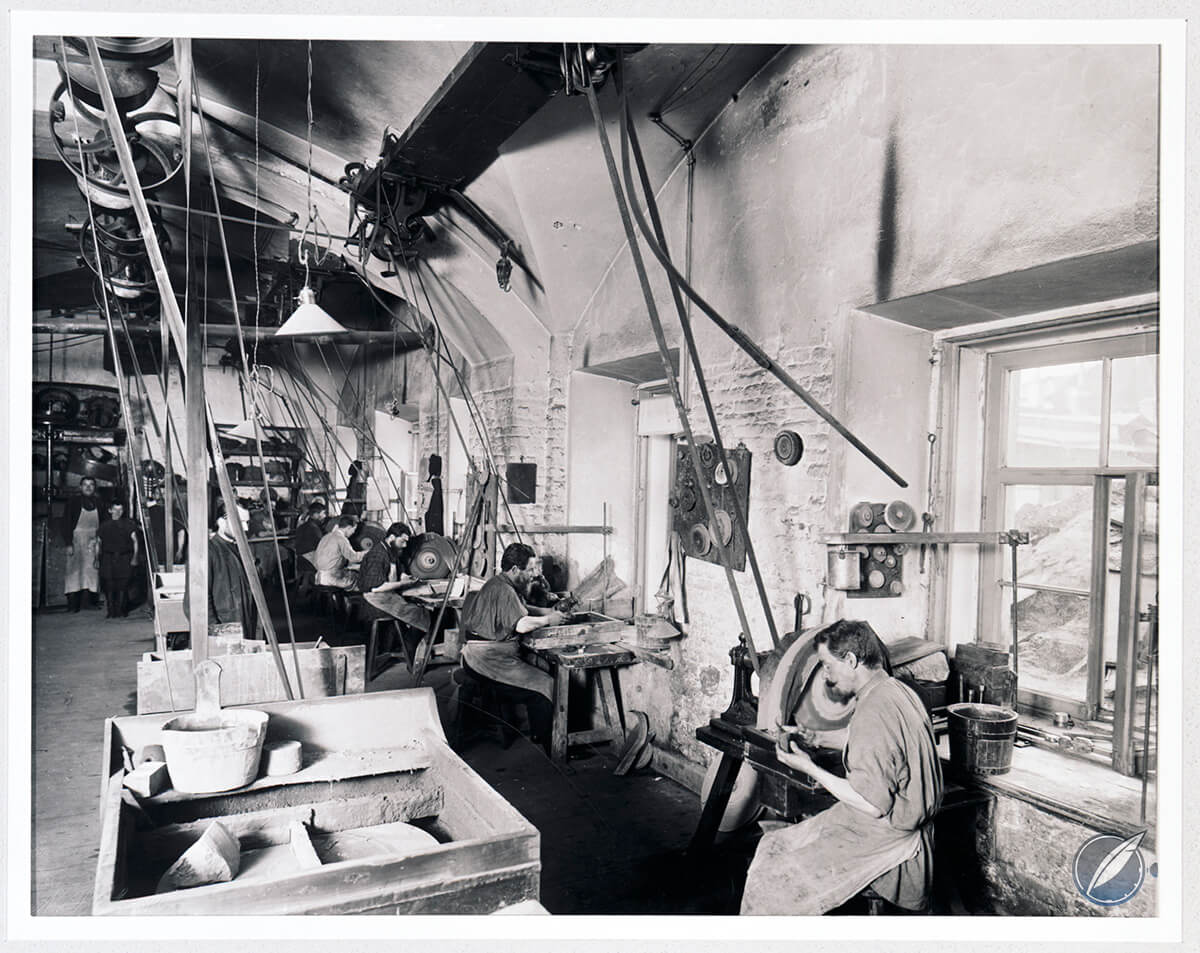
One of the original Fabergé workshops (photo courtesy Dr. Geza von Habsburg)
That same year he also commissioned his first Easter egg from Fabergé as a gift to his wife, Empress Maria Feodorovna. This became a yearly tradition, with Fabergé creating more than 54 eggs in total for the Russian court.
What makes them so special is that each egg seems to posess a soul of its own. This is thanks to the great variation among them, which is said to come from the fact that even the tsar himself did not know how the annual egg would look like before it was presented, as Fabergé was given complete artistic freedom.
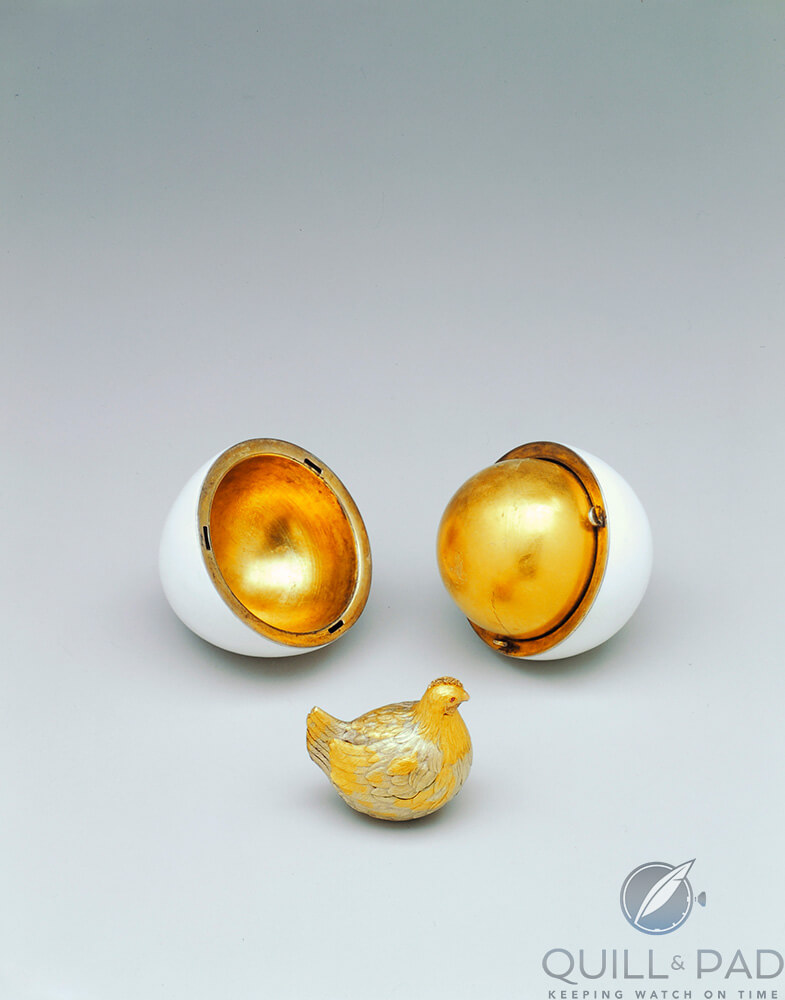
Pre-1917 Fabergé Hen Egg (photo courtesy The Forbes Collection)
The Russian Revolution ended the tradition of the imperial Easter eggs. However, it was revived in 2015 with the introduction of the Pearl Egg. Again, this was a breathtaking unique piece. However, instead of being created for Russia’s royalty, its new owner was Hussain Ibrahim Al-Fardan, a man from a family of one of the oldest and the most successful pearl traders in the Gulf region (see Fabergé Pearl Egg: The First Imperial-Class Egg In Nearly 100 Years).
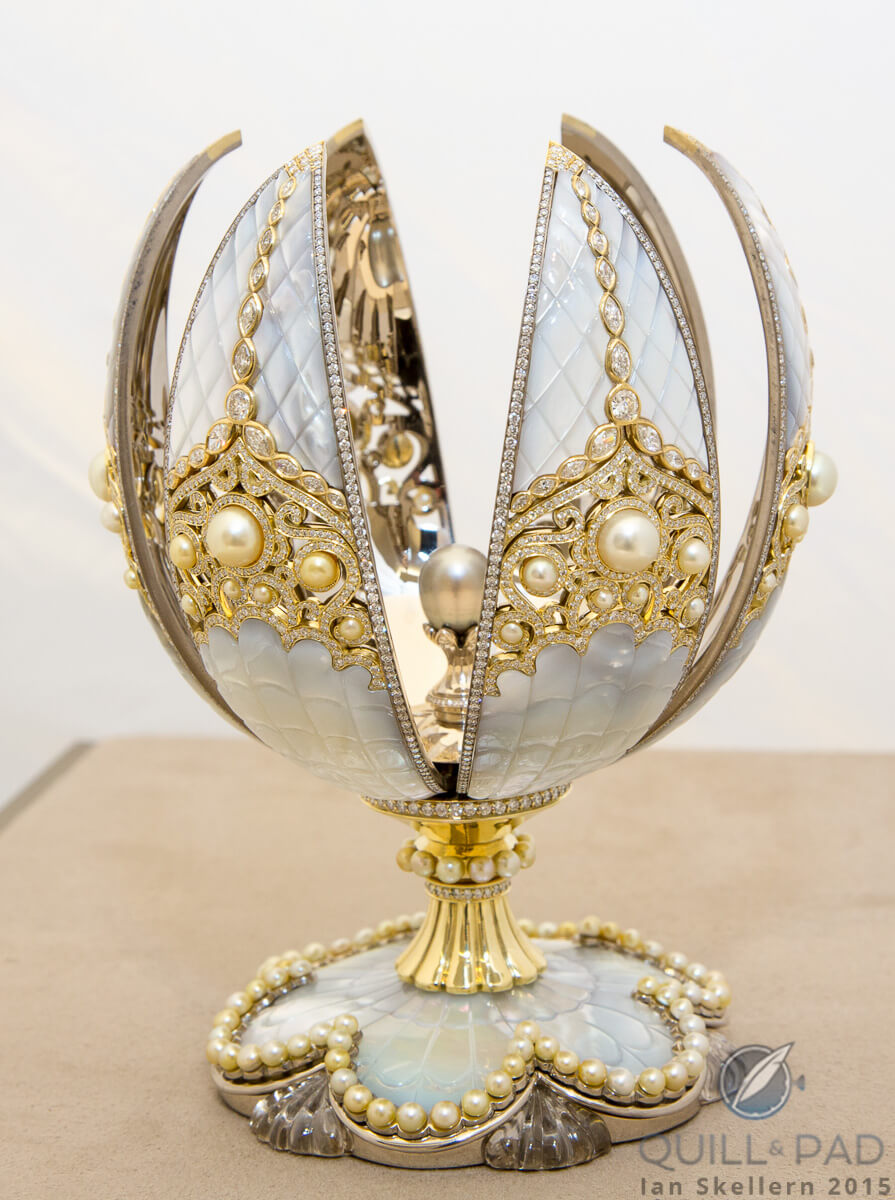
Fabegé Pearl Egg open revealing the rare 12-carat grey pearl inside
Although the imperial Easter eggs will forever be firmly connected to the Fabergé name, this jeweler created a lot more than “just” eggs. Fabergé was also masterful in carving semi-precious gemstones. The attention to detail was stunning. One example constitutes flowers and leaves carved in a vase where water was simulated by the use of colorless rock crystal (quartz).
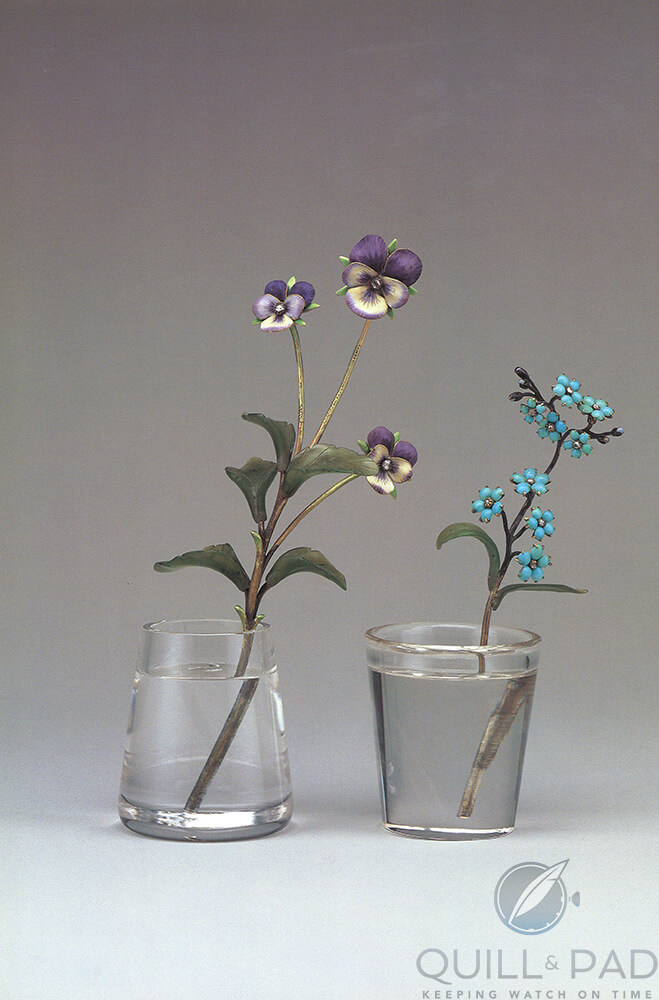
A wild pansy sprig and a forget-me-not in a vase, all of which was expertly carved by Fabergé workmaster Henrik Wigström for a convincing trompe l’oeil (photo courtesy The Forbes Collection)
Enter Gemfields
This is also why the merger in January 2013, between Fabergé and Gemfields, a mining and distributing corporation specialized in colored gemstones, made so much sense. It gave Fabergé unprecedented access to the highest quality of colored gemstones, while Gemfields would actually have the opportunity to be involved in the entire creation process, and not “only” as a supplier of colored gemstones.
It’s an example of vertical integration at its finest.
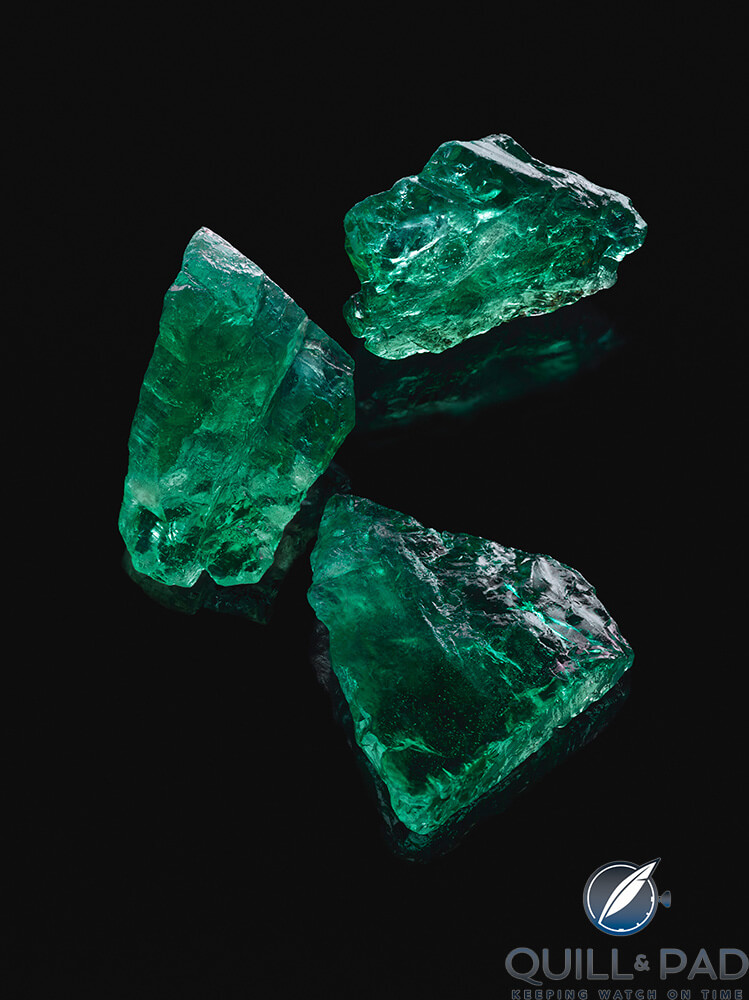
Three uncut emeralds from Gemfields
In terms of mining corporations, Gemfields is a bit of an outsider. Not in the way it mines the stones, but more so in the way it conducts its business. It combines ethical behavior with an environmental conscience, actually making this one of the pillars of the organization. This is unique because, although ethical behavior is actively stimulated by international standards and regulations for diamonds, it has yet to be very developed for colored gemstones.
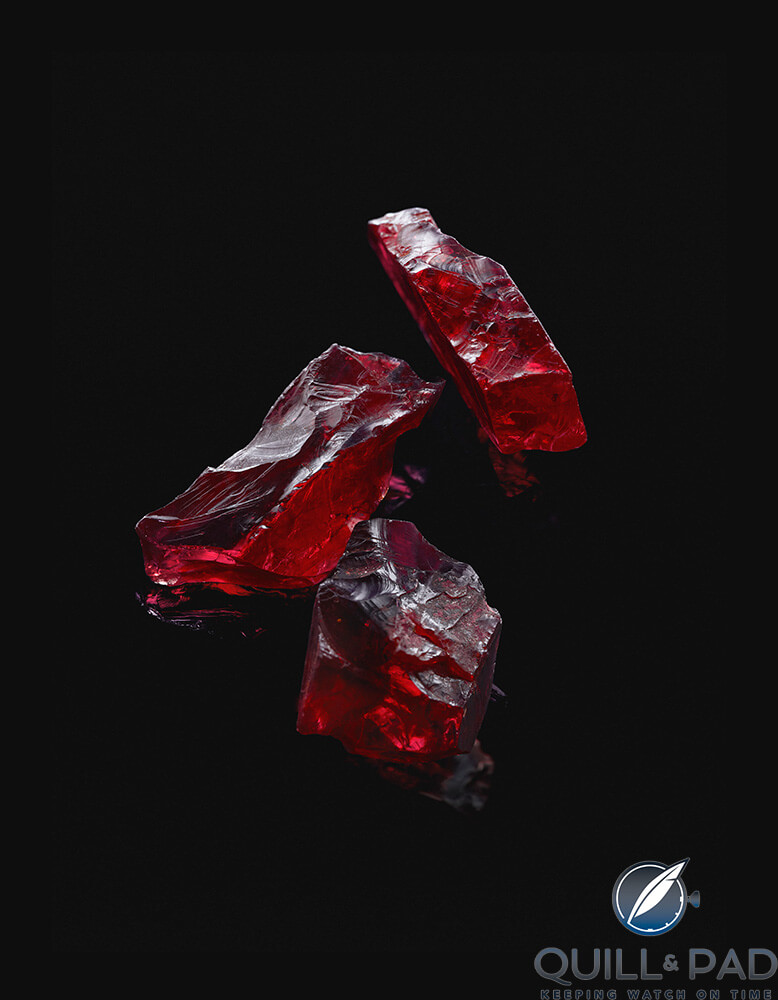
Three uncut rubies from Gemfields
Unearthing any type of precious stone has an impact on the environment. By combining knowledge with cutting-edge technology and ethical responsibility for actions, Gemfields limits its environmental impact to the absolute minimum.
Gemfields focuses on three very special stones: one is the amethyst. This may come as a surprise because low-grade amethyst has made its way to consumers in bijoux-types of jewelry for decades. However, you have not yet seen amethyst until you have seen a high-grade version of this stone. Its color is so deep and vibrant purple you would almost think that it has the power to resurrect Prince (which, unfortunately, it does not).
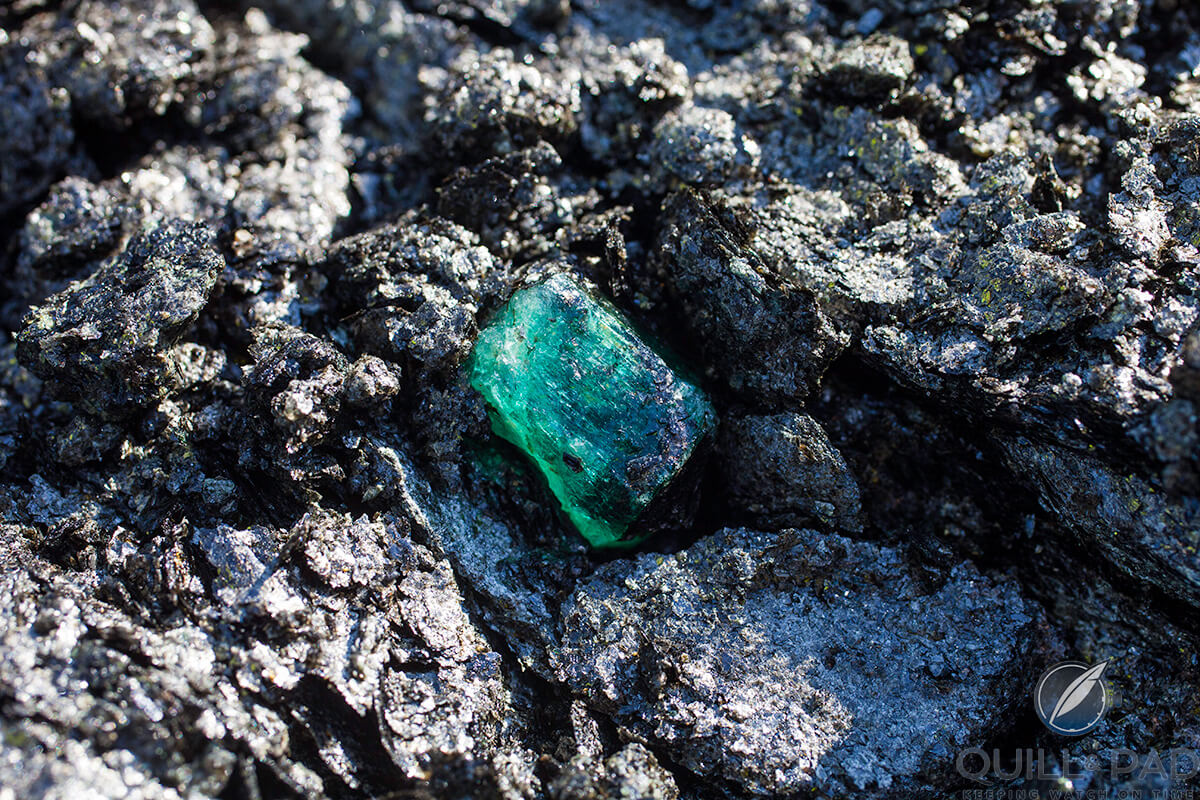
Gemfields emerald in the wild (photo courtesy Adrian Fisk-Kagem)
Then there is the ruby, a stone that has been held in high regard since ancient times. Its blood-red appearance has infatuated kings and queens, nobles, and common men alike for millenia. Rubies are a variety of corundum, just as sapphires are. The added element chromium gives rubies their prized red color.
The third precious stone Gemfields is specialized in, emerald, is of particular note. With its mystical green color, this stone is often not free from inclusions. Whereas with diamonds inclusions greatly influence value, with emeralds it makes up part of the character of the stone.
Gemfields is one of the largest producers of emeralds in the world.
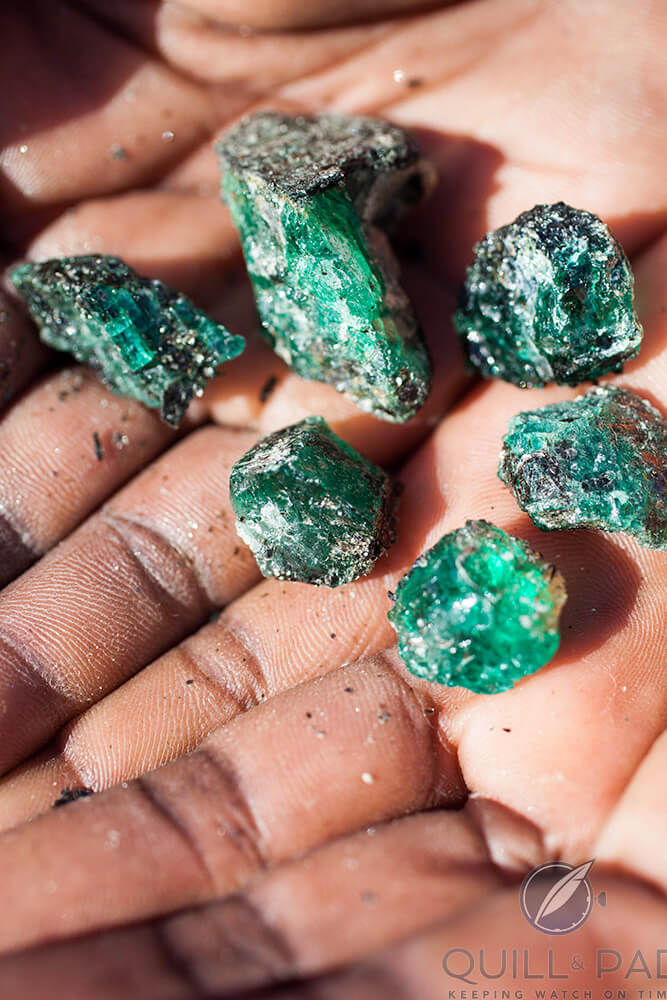
Gemfields emeralds in the hand (photo courtesy Adrian Fisk-Kagem)
The inclusion rate and color also makes grading colored gemstones a bit different from diamonds, because cut and carat weight have their impact on the value of a colored gemstone, but so has color.
Unlike for diamonds, it’s far more difficult to create a uniform grading system. Hue and saturation play a huge role as does the clarity of the stone. That is why with colored gemstones you often look at the overall picture instead of grading each item at a scale. The character of a stone is what ultimately determines its desirability on the market, and therefore its value.
Surprising Baselworld introduction
It’s also the emerald that was part of a surprising introduction by Fabergé at Baselworld 2016. Under the guidance of Fabergé’s director of timepieces, Aurélie Picaud, Gemfields’s finest emeralds were used in a watch that alludes to Fabergé’s unique expertise in carving gemstones.
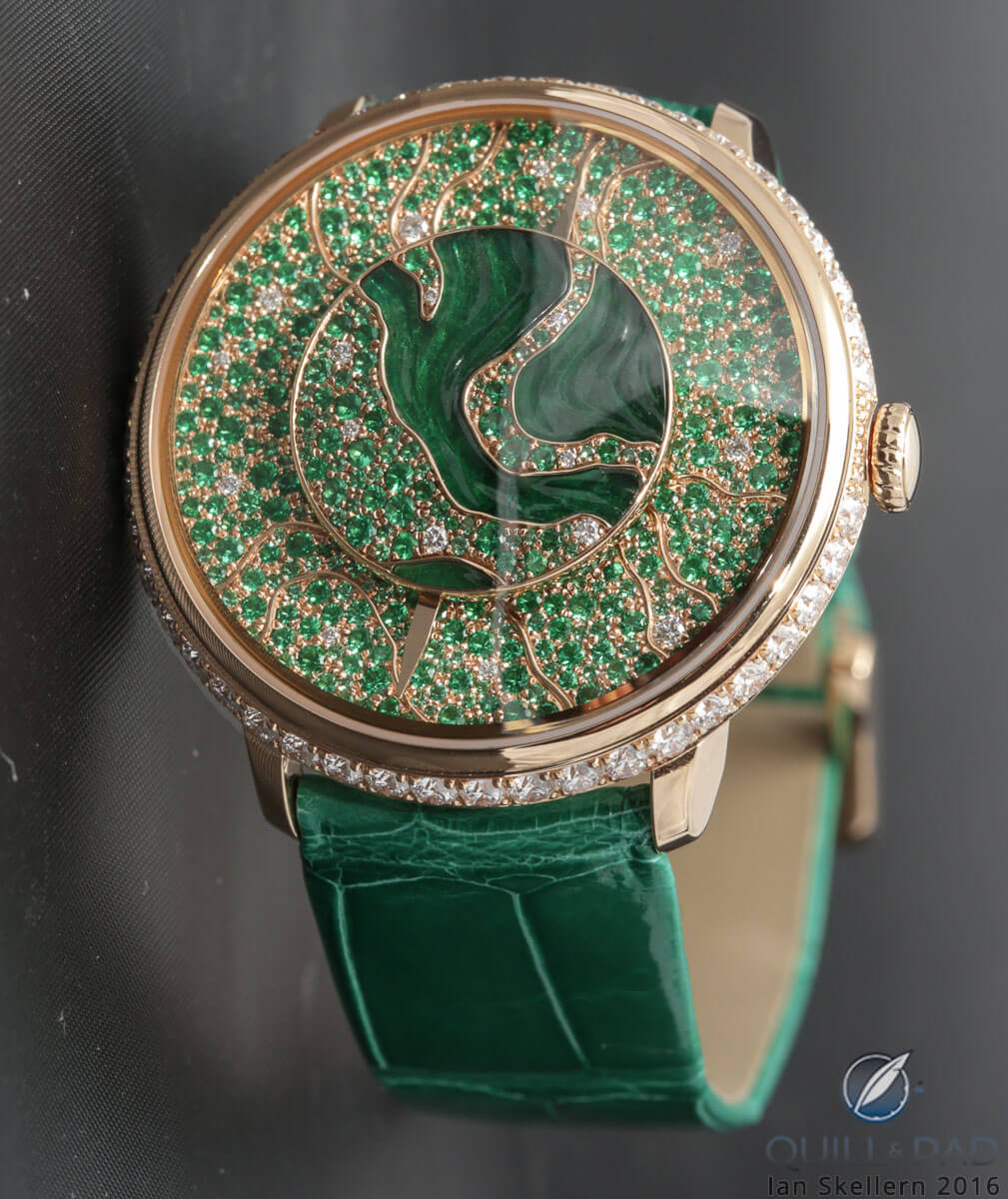
Fabergé Lady Libertine I
The Fabergé Lady Libertine I was one of the stars of Baselworld 2016 together with the Fabergé Visionnaire DTZ – and for good reason. “Say it with emeralds” would be a good catch phrase for this watch, since Fabergé’s craftspeople were able to create a small landscape by using this precious stone in a unique way. See Fabergé’s Visionnaire DTZ: A Surprising Way To Display A Second Time Zone for more on that watch.
The design of the dial, with its hands coming out from underneath a small dome positioned at its center, is actually inspired by the rolling hills of the Zambian landscape as observed from an airplane. Zambia is the country where Gemfields mines its emeralds.
The large, uniquely cut emeralds are shaped to form green rivers surrounded by sparkling brilliant-cut emeralds applied in a so-called snow setting, where precious brilliant-cut stones of different sizes are set seemingly at random. When this is done with colorless diamonds, it does indeed look like fresh, fallen snow. The result with emeralds is, however, completely different.
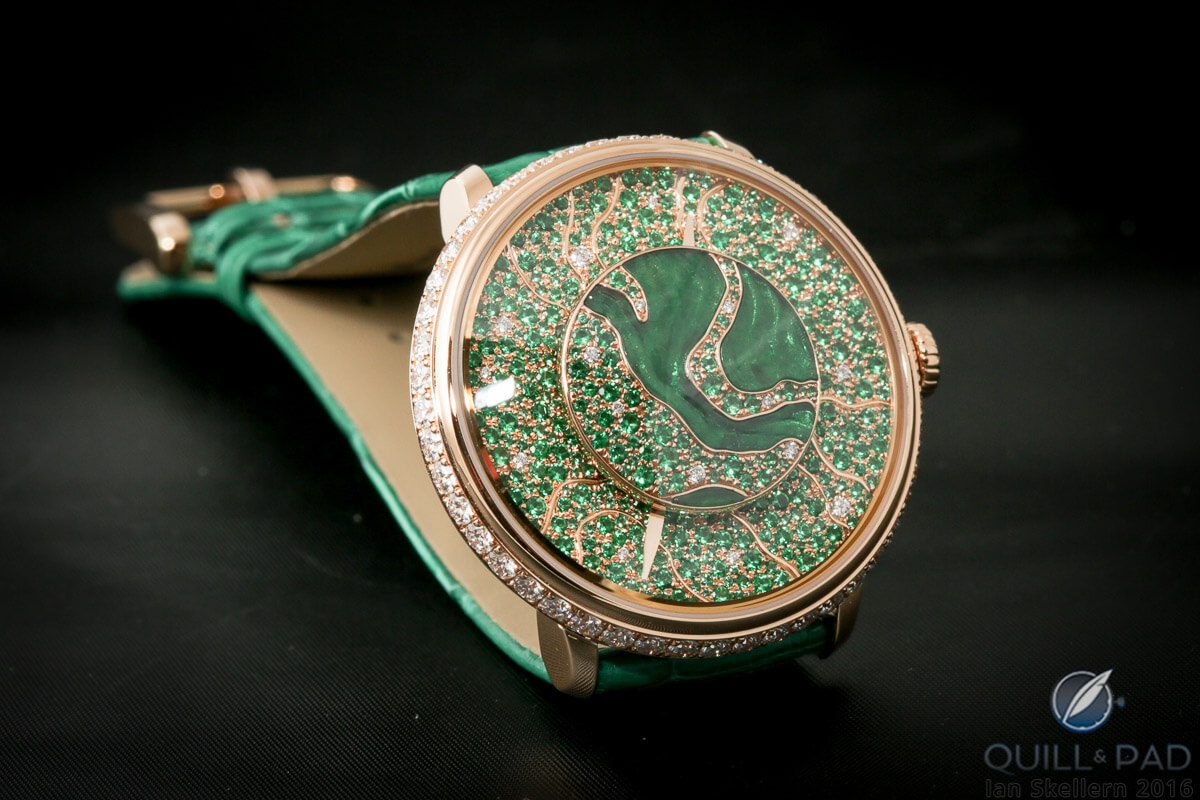
Fabergé Lady Libertine I
Thanks to the deep green hues of the precious stone and the way it is cut, the effect on the dial looks like you are flying over an impregnable tropical forest. It almost makes you look more closely, trying to hear monkeys and tropical birds.
Combined with the 18-karat pink gold of the case, the Lady Libertine I is a study in beautiful contrast. This is even enhanced by a few diamonds sprinkled among the snow-set gems as well as the diamonds set on the watch’s bezel.
With a diameter of only 36 mm it’s a very elegant watch, yet at the same time large enough to allow the observer to enjoy all the wonderful dial details and admire the craftsmanship it took to create it.
That craftsmanship can also be found on the inside of the watch, because just like the Fabergé Visionnaire DTZ, this watch is powered by a manually wound movement developed by Agenhor (see First Look: The Surprising Movement Of The Fabergé Visionnaire DTZ Dual Time Zone).
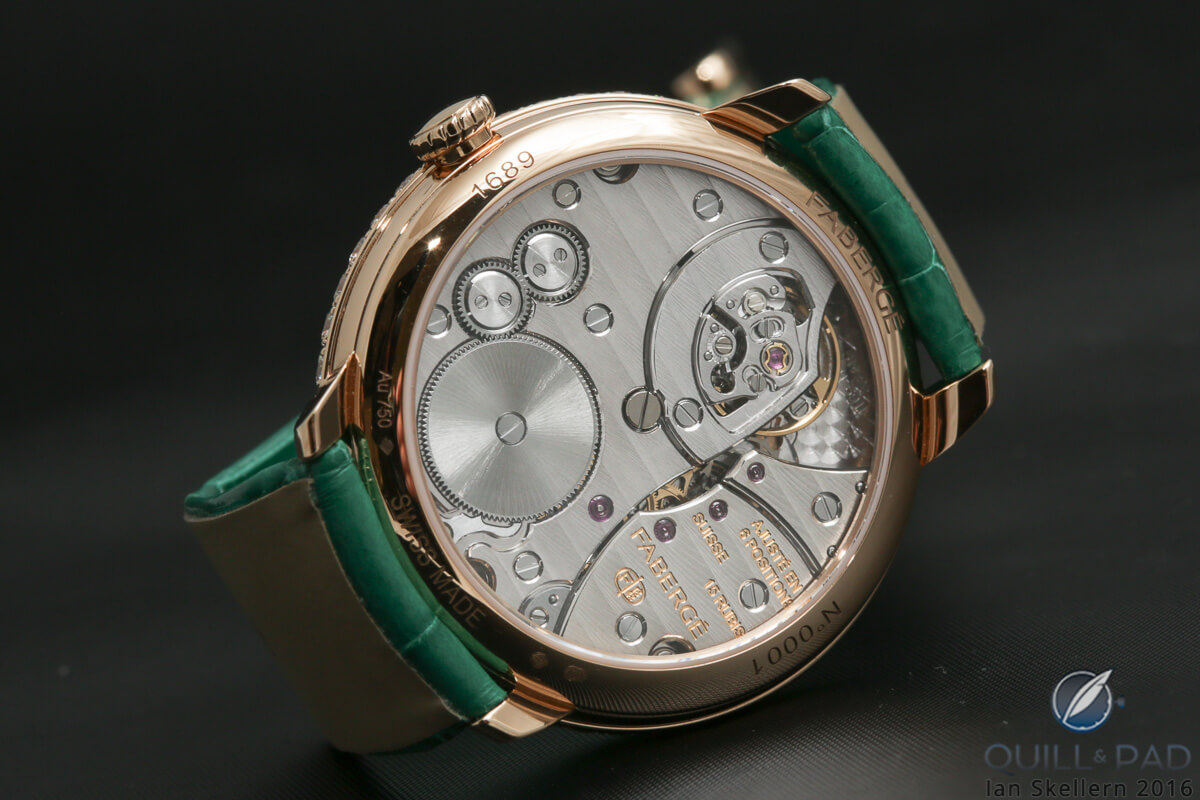
View through the display back of the Fabergé Lady Libertine I
Founded by Jean-Marc Wiederrecht, Agenhor is the last piece of the puzzle where the “new” Fabergé is concerned.
Combined with the precious gemstones of Gemfields and the jewelry expertise of Fabergé, Agenhor adds high-quality, custom-designed and built movements to the mix, making this watch and others that carry the Fabergé label true haute horlogerie.
In a sense, the Fabergé Lady Libertine I brings it all together; it revitalizes the unique skills and expertise of Fabergé’s gemstone carvings and does so with the high-quality emeralds that were unearthed, cut, and polished by Gemfields.
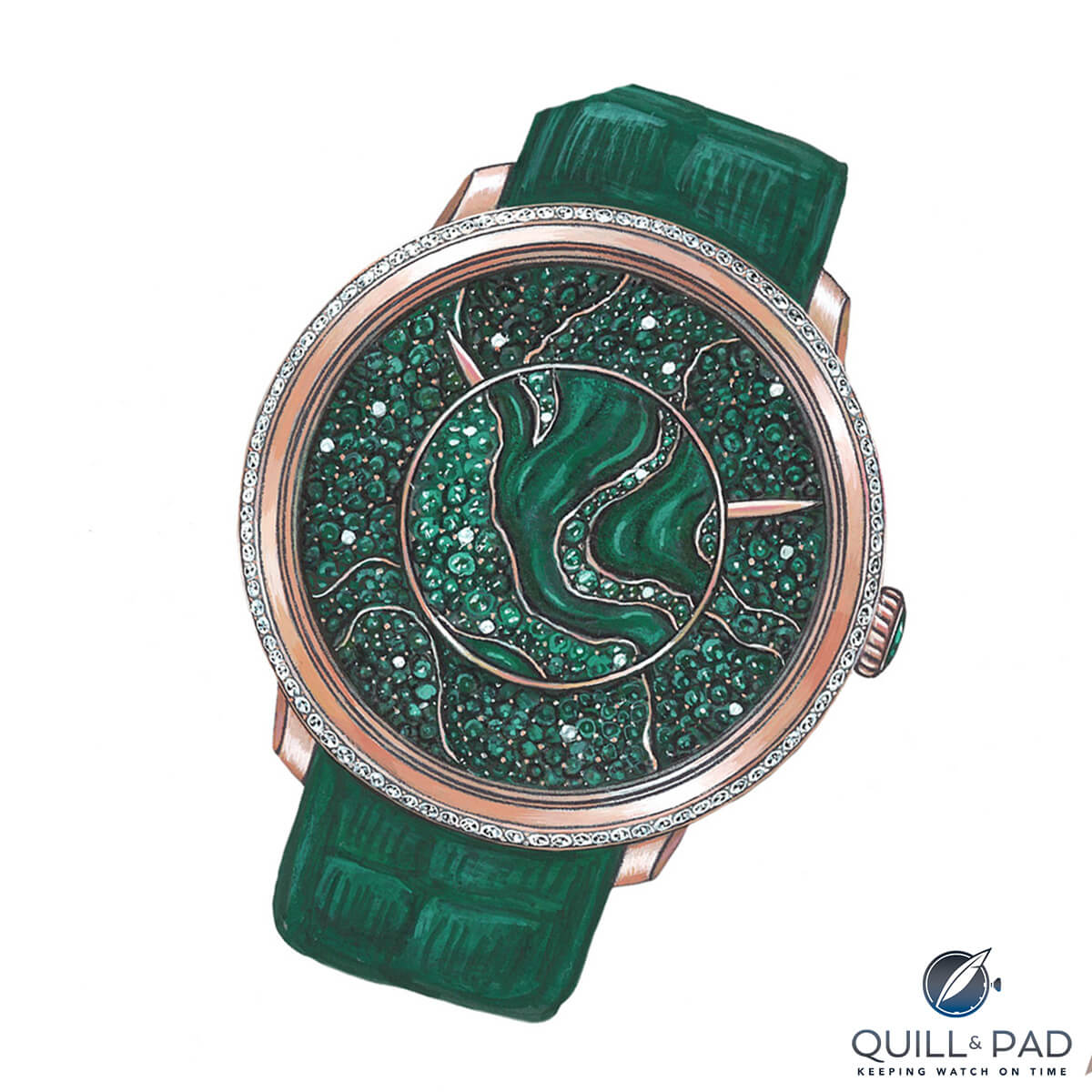
Fabergé Lady Libertine I
Making it into a timepiece just adds an extra dimension to the experience, achieving not only vertical integration, but also colorful synergy.
For more information, please visit www.faberge.com/1689_faberge-lady-libertine-i.
Quick Facts Lady Libertine I
Case: 36 mm, pink gold set with a diamond bezel (1.84 ct)
Dial: 4.08 ct emeralds and 1.93 ct diamonds
Movement: Agenhor manually wound Caliber AGH 6911
Functions: hours, minutes
Price: upon request





















































Trackbacks & Pingbacks
[…] Let’s talk about the gorgeous emeralds that adorn this fabulous piece of jewelry. Emeralds are a big part of Fabergé’s modern story as part of Gemfields, a mining and distributing corporation specialized in colored gemstones and the owner of a specialized emerald mine in Zambia. And Gemfields is one of the largest producers of emeralds in the world (see more about this in Fabergé & Gemfields’s Vertical Integration Results In Colorfully Synergistic Lady Libertine …). […]
[…] of the brand’s classic traditions. These include, of course, jewelry watches such as the Lady Libertine I, II, and III – the latter a collaborative timepiece with two other ultra-creative females in the […]
[…] the creation of colorful objets d’art, one culminating in 2106’s Lady Libertine I (see that in Fabergé & Gemfields’s Vertical Integration Results In Colorfully Synergistic Lady Libertine I), a timepiece that also pays homage to an African landscape in which Gemfields mines its precious […]
[…] Further making the case for emeralds, the Fabergé Dalliance collection also debuted a couple of Lady Libertine timepieces this year that incorporate the vibrant green gem into their gorgeous designs (see Fabergé & Gemfields’s Vertical Integration Results In Colorfully Synergistic Lady Liberti…). […]
[…] This is the same movement and technique, by the way, that is found in the Fabergé Lady Libertine I (see Fabergé & Gemfields’s Vertical Integration Results In Colorfully Synergistic Lady Libertine I). […]
[…] Since founding his company in 1960, Laurence Graff has seen it evolve into a powerhouse of knowledge and expertise when it comes to gemstones. His success enabled him to secure a steady supply of the best stones, and much like Fabergé he and his employees know what to do with them (see Fabergé & Gemfields’s Vertical Integration Results In Colorfully Synergistic Lady Libertine …). […]
Leave a Reply
Want to join the discussion?Feel free to contribute!